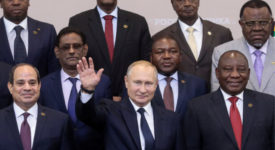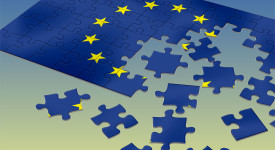Pioneers of a European Diplomatic System
Heidi Maurer a Kristi Raik (Finnish Institute of International Affairs)
The European External Action Service (EEAS) is a product of the Lisbon Treaty, created primarily to represent the EU abroad. Foreign policy has traditionally been one of the most important areas in the agenda of nation states’ governments who sought to employ it to gain vital political influence abroad and often also score useful political points at home. It is no surprise then that individual EU member states often resist attempts to elevate the foreign policy dimension to the transnational level, even though some of these proposals may bear fruit for all parties. A good example is the lack of common European energy policy, which allows Russia to use its gas and oil supplies to Europe to its advantage in diplomatic talks with EU countries. President Putin is well versed in this kind of realism – after all, it was the subject of his university dissertation.
Slowly but surely, member states have begun waking up to the fact that EU diplomatic missions are not replacements-to-be of national foreign policies. Rather, they aim to coordinate states’ missions and assist them, if necessary. For example, the EU mission to Washington D.C. is invaluable for small and medium-sized member states, which are enabled through the EU mission’s meetings of all EU states representatives with the US officials to gain access to influential contacts in the US state department. On the contrary, the EU mission to Moscow plays a secondary role given the Russian officials’ preference for bilateral meetings.
The lesson for Brussels lies in learning to take into account the information emanating from individual missions, national or transnational, and utilising it to form a harmonious and coherent foreign policy. State delegations themselves should realise that an ad hoc intergovernmental foreign policy is insufficient in our day and age, and working towards a long-term transnational foreign policy is essential.
(The study can be downloaded here: http://www.fiia.fi/en/publication/415/pioneers_of_a_european_diplomatic_system/)
Partners in Crime? The EU, its Strategic Partners and International Organised Crime
Thomas Renard (Egmont – Royal Institute for International Relations)
In recent years, the EU has been stepping up its game against organised crime. This problem encompasses many distinct wrongdoings, from money laundering to terrorism to human trafficking. The nature of criminal organisations has shifted due to globalisation and continuing EU integration, elevating their workspace to international structures. Additional aspects which influence the present shape of criminal organisations are the current economic crisis and proliferation of internet and communication technologies. Moreover, Europe is a major hub of organised crime.
It was the Treaty of Maastricht that first anchored anti-organised crime solidly into the EU’s scope of competences, establishing an intergovernmental ‘third pillar’ focused on justice and home affairs. However, the treaties adopted later also helped tackle the problem. The 2003 European Security Strategy (ESS) identifies organised crime as a key threat for the EU, while recognising that it is an ‘internal threat’ with an ‘important external dimension’. The European Commission’s 2010 Internal Security Strategy in Action (ISS) places disruption of international crime networks as its number one priority, identifying concrete actions to deal with it. Yet, despite the long-established commitment and the identification of organised crime as a fundamental internal and external security threat, the EU has not yet issued an overall strategy to deal with this problem. There are merely several relevant EU documents that focus on specific dimensions of this policy domain.
International partnerships are essential in developing an overall anti-organised crime strategy. The Stockholm Programme (2010) recognises that the EU should focus on ‘key partners’ and step up its cooperation with such partners, singling out Russia and the US and binding them to continued cooperation in this field, despite their disagreements over the crisis in Ukraine. The partnership with Russia is complemented by EU financial assistance, in order to improve Moscow’s ability to cope with internal security problems. The partnerships with transatlantic countries deal primarily with mutual assistance in fighting drugs and cigarettes smuggling. The EU-Japan partnership is concerned mainly with money laundering and drug trafficking. The EU is capable of unitary decision-making, especially in the internal dimension. In the external dimension, however, the EU remains a nascent actor, with most operational capabilities still in the hands of member states. To change this, the EU must become more assertive and effective as a global actor in combating organised crime, both vis-a?-vis its member states and partners.
(The study can be downloaded here:
http://www.fride.org/publication/1191/partners-in-crime?-the-eu,-its-strategic-partners-and-international-organised-crime)
Addressing Weak Inflation: European Central Bank’s Shopping List
Grégory Claeys, Zsolt Darvas, Silvia Merler and Guntram B. Wolff (Bruegel)
Price stability is one of the key goals of the European Central Bank (ECB) institutionalised in the European Treaties. According to the ECB’s definition, price stability necessitates an approximate 2 percent inflation rate. However, these days the core euro area countries like France and Germany keep their inflation lower (around 1 percent), with some peripheral states’ economies in deflation. There are several ways to increase inflation to the desired 2 percent threshold. One is lowering the ECB’s interest rate for bank deposits, or even issuing negative interest rates. Another is ending the sterilisation of bond holdings from the Securities Markets Programme (SMP), or creating new long-term refinancing operations. However, under the current circumstances in the euro area, none of the above methods would lead to a tangible improvement.
The one viable method to increase inflation seems to be asset purchases, which has been chosen by the American Fed and the Bank of England in dealing with the brunt of the economic crisis and which is also supported by multiple academic findings. After assuming a positive 0.2 percent inflation effect of a 1 percent of GDP asset purchase in the euro area, this study proposes to commence with €35 billion of asset purchases per month. This should result in increasing the yearly inflation rate to the desired 2 percent mark. Government bond purchases would be significantly beneficial, but in a monetary union with 18 different treasuries, such purchases are difficult for economic, political and legal reasons. Similarly, bank bonds should be excluded from the ECB asset-purchase programme until the ECB’s Comprehensive Assessment is concluded.
This study recommends that the ECB purchase bonds issued by the European Financial Stability Facility (EFSF), the European Stability Mechanism (ESM), and the EU-wide bonds of the Euro- pean Investment Bank and European Commission. Corporate bonds may also be purchased, as the current owners of the corporate bonds would sell their bonds and use the cash for different purposes throughout the euro area. Another class of assets that could be bought by the ECB is asset-backed securities (ABS): more than half (€612 billion) of these are based on residential mortgages, which were among the best performing category of securitised products in 2013.
Low inflation in the euro area is particularly dangerous, given high private and public debt levels in several euro-area countries. By acting as soon as possible, the ECB may manage to avoid having to adopt more sweeping directives. At this moment, the monthly €35 billion asset purchases with a revision every third month seem optimal, as they will allow the ECB to stop purchasing once euro area inflation hits two percentage points. The portfolio of assets to be purchased should be sufficiently diversified to minimise risk. At the same time, the ECB should avoid exposure to unchecked political and private sector pressures that could result in delays to the reversal of asset purchases, thus undermining the bank’s price stability mandate.
(The study can be downloaded here: http://www.bruegel.org/publications/publication-detail/publication/826-addressing-weak-inflation-the-european-central-banks-shopping-list/)







